The right restaurant management software significantly enhances efficiency and control of operating costs. MarketMan offers tools for automating invoicing, recipe costing, and food cost calculations, making it a popular choice among restaurateurs.
However, with numerous similar systems available, tailored to various types of food service operations and specific use cases, you might ask, ‘Which software is the best fit for my business?’
This article explores MarketMan’s features and assesses their suitability for different restaurant types. We also analyse customer feedback from platforms like G2 and Capterra to highlight the pros and cons users have encountered.
Finally, we will explore the best alternatives to MarketMan, helping you decide which restaurant inventory management platform aligns best with your needs.
MarketMan’s Core Features
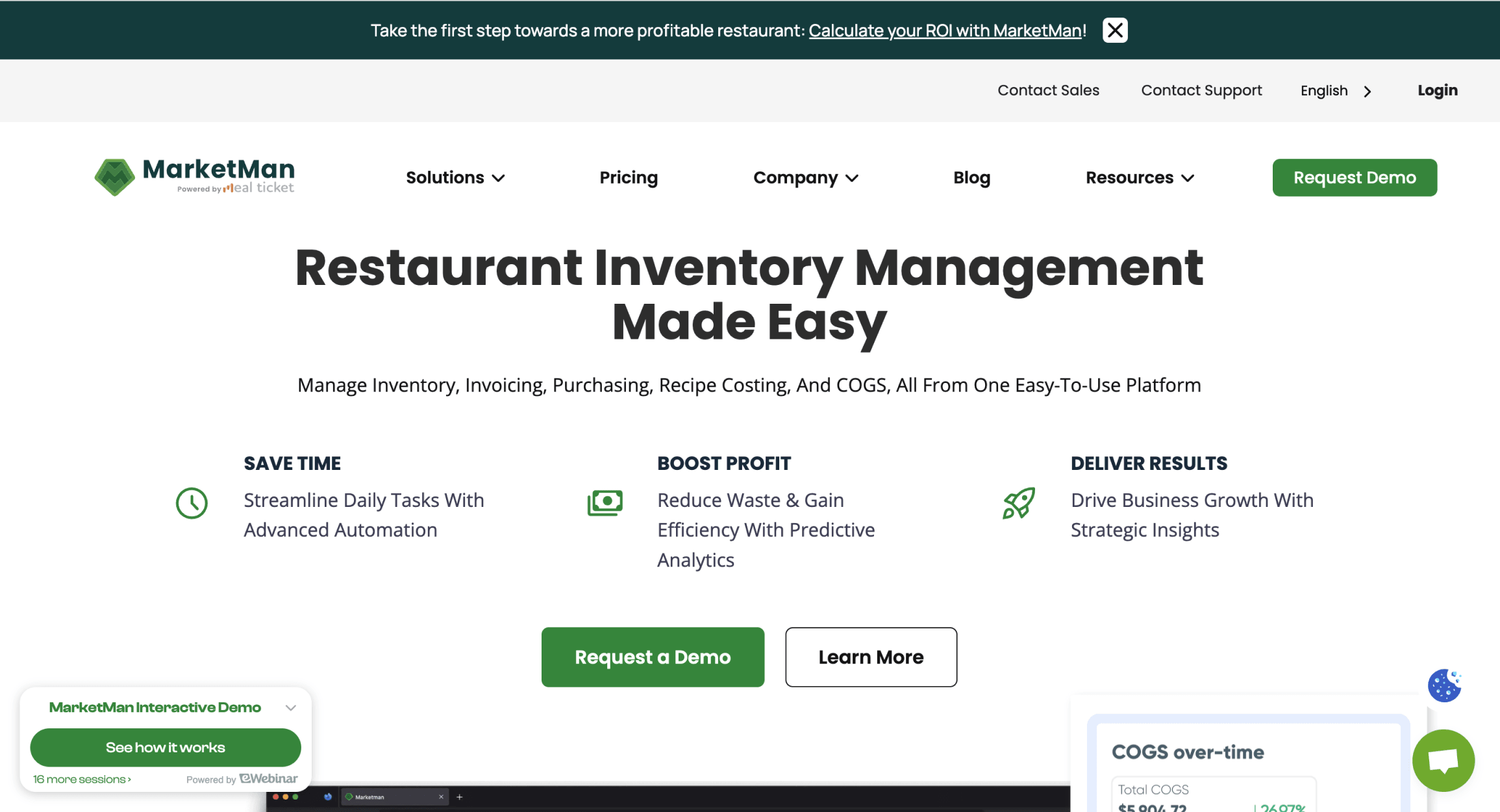
MarketMan stores your recipe, ingredient, and inventory data and automates many restaurant management tasks, such as inventory counts, cost calculations, and purchasing. It runs in the cloud, so these functions are available wherever you are on any device.
Here are the most important features of the platform and what they help you do.
- Inventory management: MarketMan tracks inventory and reports on stock counts and total value. It helps you track waste and theft to better control running costs.
- Expense tracking: MarketMan Snap is an app that lets you take photos of receipts and invoices and upload them to the system. It can analyse the images and extract information.
- Purchasing and order management: The software digitises purchasing and ordering. You can set alerts and order to PAR. MarketMan tracks ingredient prices to help optimise menu prices.
- Multi-unit management: MarketMan lets you connect multiple sites to the system. This allows you to improve communication between locations and transfer items.
- Digital cookbooks: MarketMan stores your recipe data by creating digital cookbooks for each restaurant. These cookbooks display the portions, methodologies, and quantities needed to produce the dishes.
- Recipe costing: The system calculates the theoretical cost of producing a menu item. It generates reports on profitability so you can refine your menus to improve margins.
- Vendor payment: This feature streamlines payments to suppliers, allowing you to track deliveries and invoices and make payments. You can track spending over time and receive alerts on price changes.
MarketMan Pros & Cons
Below are the biggest pros and cons of MarketMan’s software, based on user reviews on software comparison websites such as G2 and others.
Pros
Overall, users are positive about MarketMan’s capabilities. Several users say MarketMan is easy to use or that it’s easy to train employees to use the system. Many say automation features like invoicing, scanning, and cost calculation are great time-savers. One customer praises the ability to track the costs of inventory items and recipes, saying it allows a restaurant chain to give more specific feedback to managers rather than just “food cost is too high.” The app has been described as helpful and has many functionalities.
Cons
Complaints are mainly about the limited support MarketMan offers and the system’s difficulties in managing non-standard operations. One user praised MarketMan as a procurement tool but thought recipe management was too technically complex and error-prone. Another said the system would often crash and mentioned that the MarketMan support team was slow to respond to urgent requests, which left the user unable to use the system. The lack of support was echoed in other reviews. Noteworthy is that while invoice scanning is seen as a pro, some users say the feature isn’t accurate, making the data unreliable.
Who is MarketMan for?
MarketMan is a versatile tool designed for restaurants of all sizes. It offers valuable insights into inventory management and cost of goods sold (CoGS). The system performs best in a straightforward business setup, such as a restaurant with nine locations, on-site production, and static recipes/menus.
Apicbase: MarketMan’s Top Competitor
MarketMan has many competitors, including accounting and cost management systems, POS systems with inventory management features, and dedicated inventory and recipe management platforms.
Its top competitor is Apicbase, an end-to-end F&B management platform that integrates with POS systems, suppliers, and BI and offers robust API endpoints to create a streamlined tech ecosystem.
MarketMan works well in all types of restaurants, from small to large. In contrast, Apicbase is explicitly designed to manage the complex operations of multi-site and enterprise-level food service companies, including central kitchens.
Here are the key features Apicbase offers that make it a strong competitor to MarketMan.
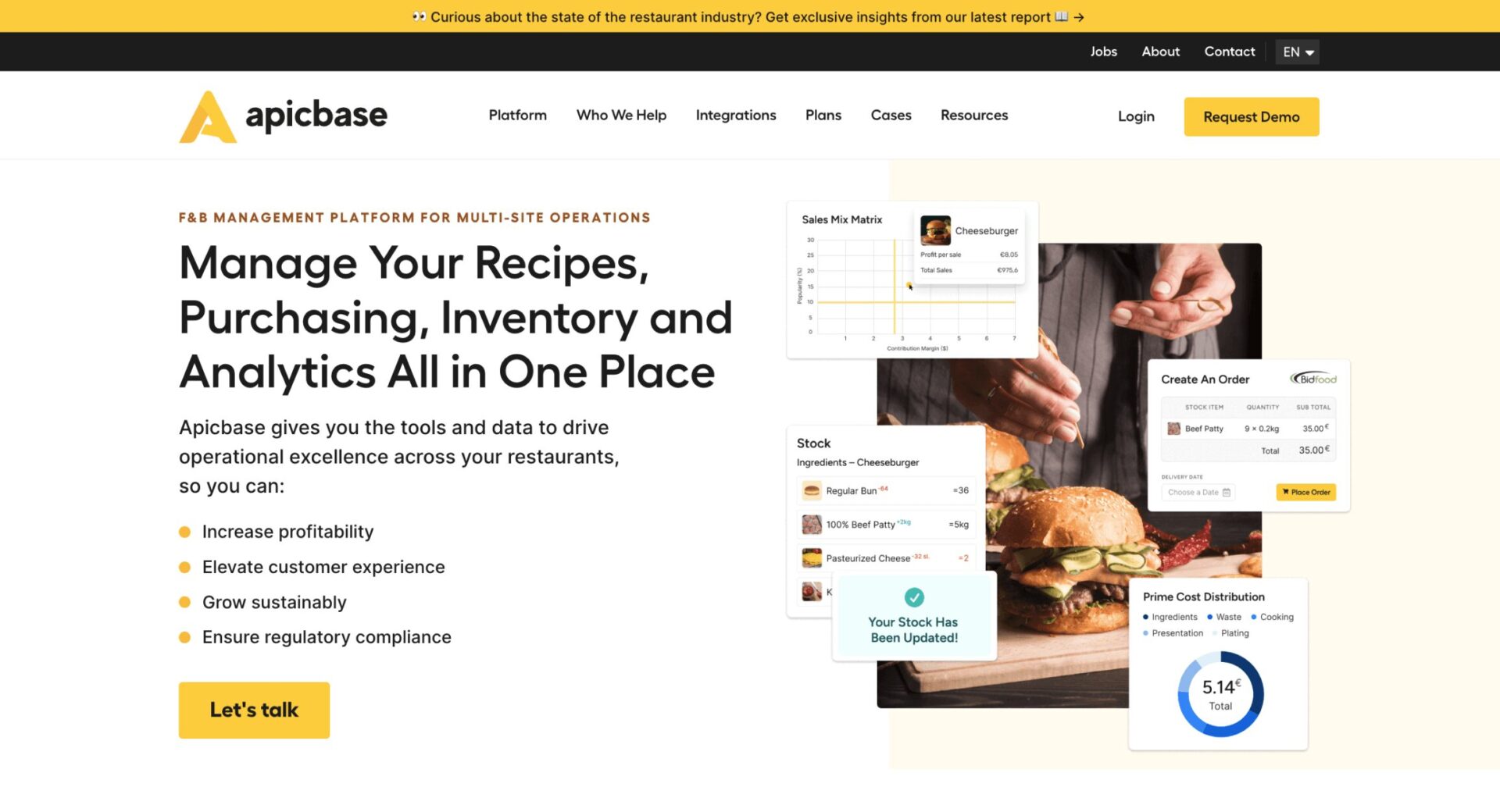
- Menu engineering and recipe development: Apicbase excels at managing complex recipe and menu data. The central database stores detailed information about your ingredients, recipes, and food costs. Apicbase calculates recipe costs and nutritional values and keeps track of allergens. Recipe information is stored centrally, allowing development chefs to create recipes and fine-tune menus easily.
- Inventory management: Apicbase tracks the levels and values of each location’s inventory. It calculates actual versus theoretical food costs to give you a snapshot of the state of inventory management and its evolution over time. Apicbase’s food waste tracking capabilities are noteworthy, allowing restaurant operations to align with ESG principles.
- Procurement and demand forecasting: Apicbase offers purchasing suggestions and pre-populated purchase orders to help restaurant managers prevent over- or under-purchasing. The system predicts purchasing needs per location, considering upcoming sales and current inventory.
- Analytics dashboards: Apicbase offers advanced analytics tools to declutter your restaurant data and gain deeper insights. For example, the sales matrix maps menu items according to their popularity and profitability. Apicbase calculates food cost variance at each location, comparing theoretical to actual food costs to identify potential savings and profit-enhancing opportunities.
- Insights hub: The platform has a built-in analytics hub with dashboards that visualise every aspect of your business. These dashboards provide spot checks by location, revealing long-term trends and exposing anomalies in the supply chain, inventory management, menu performance and cost management.
- Menu planning: Apicbase offers a robust menu planning suite with a visual calendar to schedule and plan menu cycles. The software uses inventory, recipes, vendor information, and predicted demand to help food service operations create cost-effective menus by day, category, or cycle. Menu planning syncs with production planning and purchasing to ensure seamless execution.
- Internal ordering: MarketMan doesn’t offer this feature: Apicbase provides specialised to manage stock transfers between sites efficiently. Its features are particularly valuable for central production kitchens, streamlining inventory tracking and simplifying the coordination of deliveries across locations.
- Traceability: MarketMan doesn’t offer this feature. Apicbase tracks ingredients from receiving to distribution, allowing corporate and institutional catering and packaged goods manufacturers to comply with traceability regulations.
- HACCP compliance: MarketMan doesn’t offer this feature. Apicbase’s task planning tool lets restaurant operators digitally plan and monitor daily HACCP compliance tasks. Staff performs food safety checks and duties and logs them in the cloud. In case of an audit, the necessary documents are ready for inspection.
- Production planning: MarketMan doesn’t offer this feature. Apicbase organises tasks for kitchen staff. It creates production plans that align with expected demand. Kitchen managers can generate fully costed and portioned production plans in seconds, saving time and reducing food waste due to overproduction.
- Integrations: Apicbase offers a wide range of integrations, allowing it to exchange data with other software seamlessly. This includes POS systems like Revel, Lightspeed, and Square, delivery partners such as Deliverect, and major suppliers like Brakes, US Foods, and Bidfood. These connections create a unified platform for managing all aspects of restaurant operations.
How Apicbase Compares to MarketMan
MarketMan and Apicbase offer similar services. They are regarded as the leading back-of-house management software, allowing restaurants to create recipes, connect with their POS system and order from suppliers.
MarketMan works great out of the box. However, users find its functionalities somewhat limited for complex operations, such as a head office centrally managing multiple branches or local outlets that order from and receive deliveries from central kitchens.
Apicbase, in contrast, provides a more sophisticated approach to managing recipes and suppliers, offering greater flexibility and deeper insights into menu engineering, stock movements and purchasing.
While smaller companies with hands-on founders may not require these advanced features, larger organisations particularly value the stable and innovative capabilities Apicbase provides.
In comparison to MarketMan, Apicbase has:
- Robust support and onboarding processes — Customers describe Apicbase as an essential and reliable partner in their digital transformation.
- SOC II, Type 2 Compliant — Apicbase software meets the highest standards of data security, privacy, reliability, and operational excellence.
- Advanced recipe and supply chain infrastructure — Apicbase centralises recipe management, synchronises changes across locations, and accommodates specific packaging details.
Let’s compare MarketMan and Apicbase in more depth.
Inventory depletion
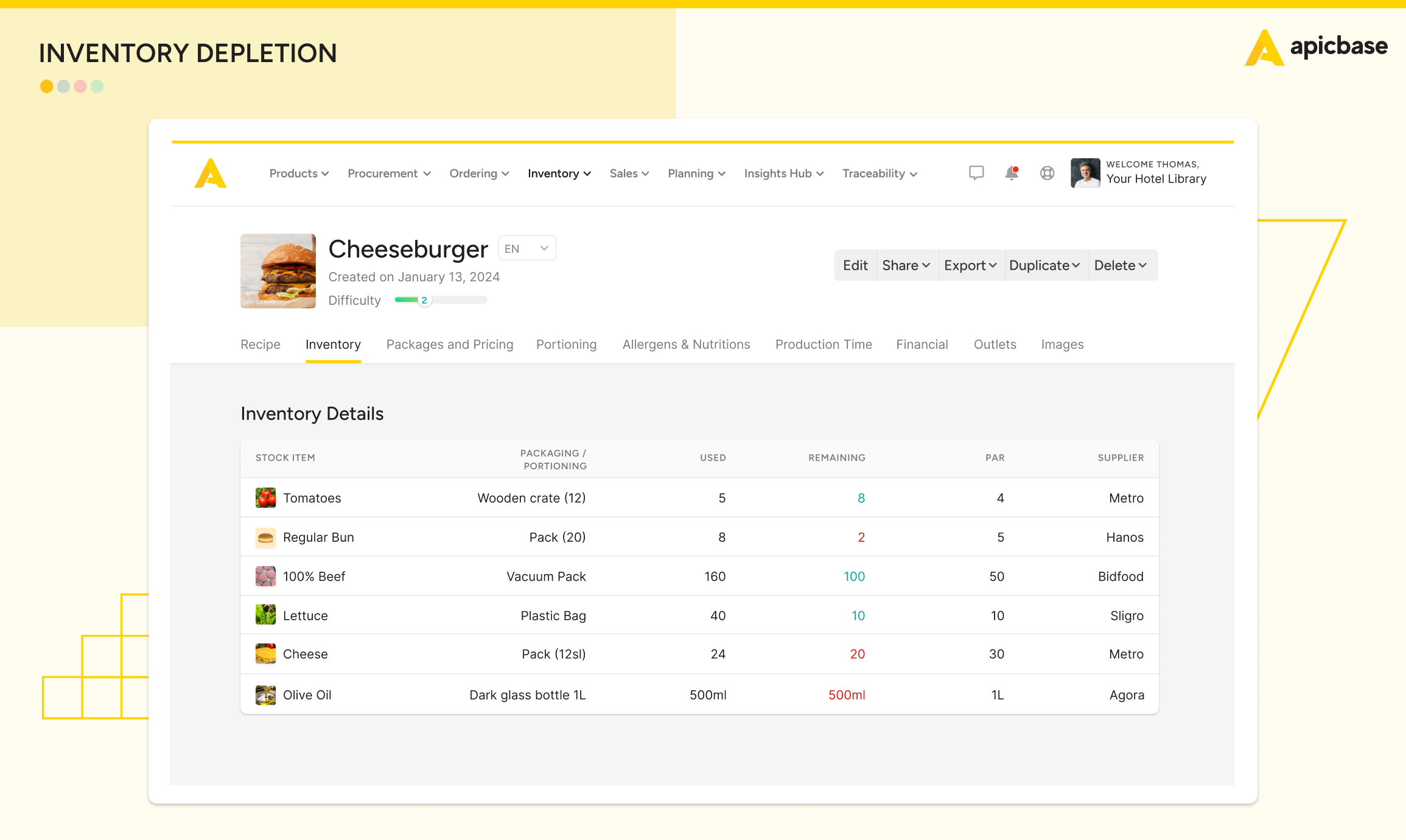
In Apicbase, each ingredient listed in a recipe is associated with the specific package format offered by the supplier. This feature is significant because it means that when a recipe is used, the inventory system deducts the exact package or portion used, reflecting the actual items as they decrease in stock.
For example, if a recipe calls for 500ml of olive oil, and olive oil is supplied in 1-litre bottles, Apicbase will accurately track the depletion of half a bottle from inventory.
Many restaurant management systems, including MarketMan, simplify stock tracking by depleting either the point-of-sale (POS) items directly sold to customers or the raw materials in generic quantities.
This can make stock depletion somewhat abstract and potentially inaccurate because it doesn’t consider how ingredients are actually packaged and used. Apicbase enhances precision in inventory management by aligning ingredient usage with how ingredients are stored and purchased. This approach ensures accurate inventory levels, minimises waste, and improves ordering efficiency.
Detailed inventory tracking is crucial for Apicbase users, particularly those managing large-scale or multi-location operations. It allows for better financial oversight, reduces discrepancies between theoretical and actual stock levels, and supports more informed purchasing and menu pricing decision-making.
Stocking semi-finished products
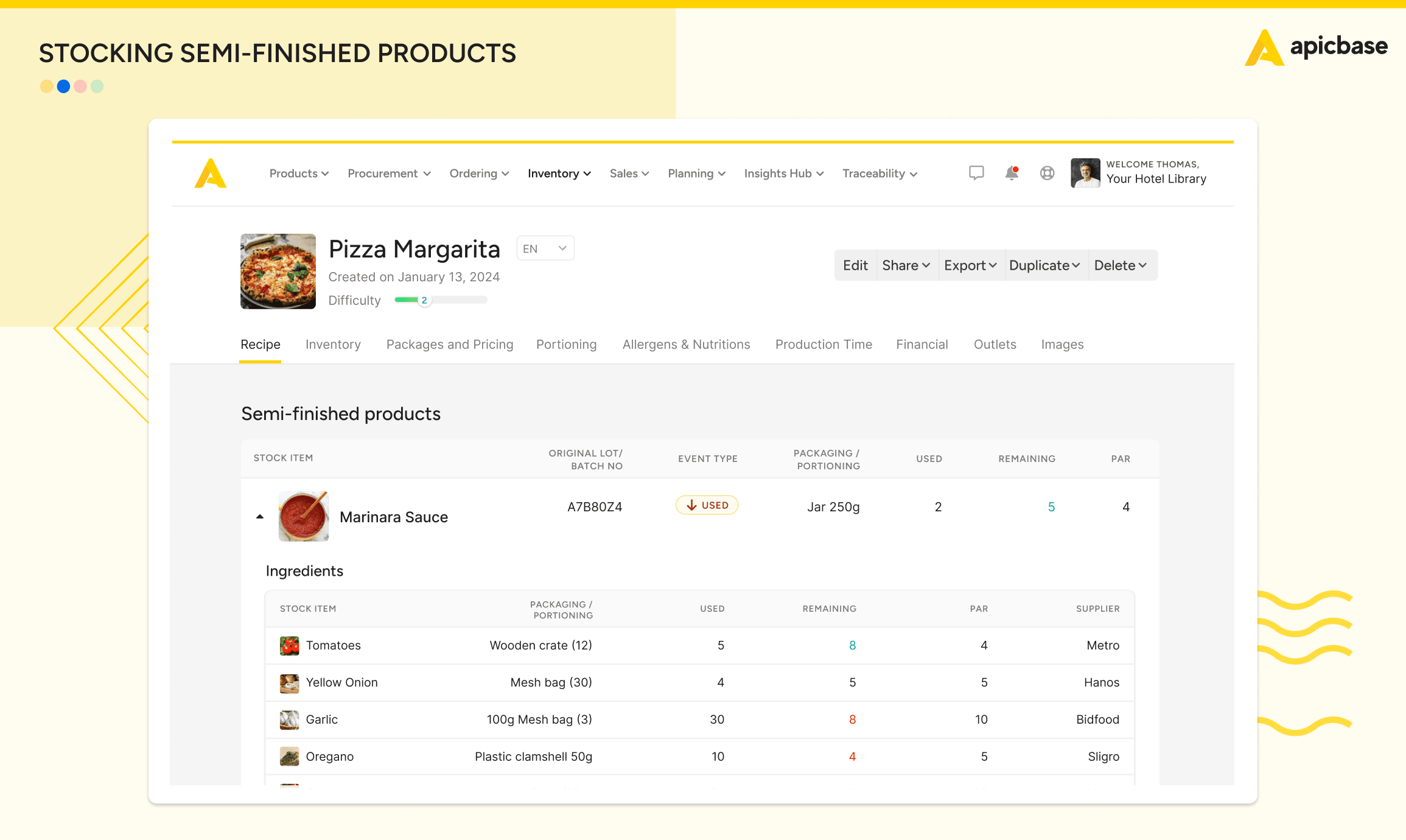
MarketMan requires a workaround to manage semi-finished products within its inventory module. Apicbase, on the other hand, can manage both the raw materials purchased and the semi-finished products created from these materials within its inventory system.
When a semi-finished product (like a sauce or prepped vegetable mix) is produced, the system automatically deducts the raw materials used from the inventory and adds the quantity of the new semi-finished product. This ensures that all ingredient movements are tracked accurately.
For example, if a kitchen produces a batch of marinara sauce, the system will subtract the tomatoes, herbs, and other ingredients from the raw materials stock while adding the completed marinara sauce as a semi-finished product to the inventory.
This is particularly interesting for central production kitchens. The differentiation between purchased goods and produced goods ensures stock records accurately reflect both raw materials and semi-finished goods, minimising discrepancies and preventing issues like overstocking or shortages.
Central Kitchens
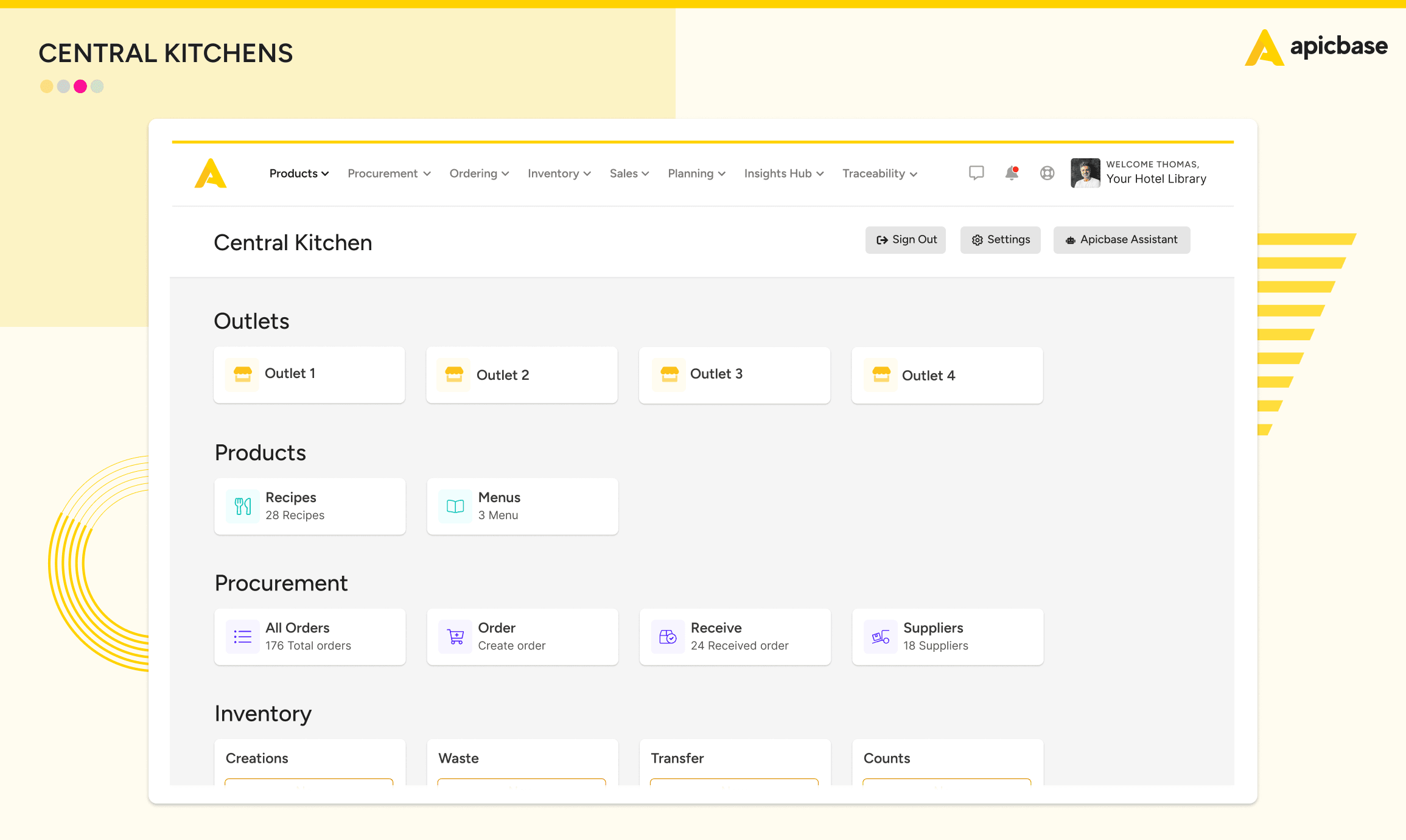
In MarketMan, the central kitchen is treated similarly to an external supplier, which means it is essentially viewed as a source of orderable items. This approach limits its integration with other aspects of restaurant management.
In contrast, Apicbase treats the central kitchen as a fully integrated part of the business, complete with production, stocking, and procurement capabilities synchronised with individual outlets’ purchasing systems.
For Apicbase users, this integrated approach is crucial because it enables accurate tracking of both central production units (CPUs) and individual outlets. It ensures that orders and product movement between the central kitchen and the outlets are recorded in real-time, helping maintain precise inventory records in the central kitchens and outlets.
Enterprise-level support
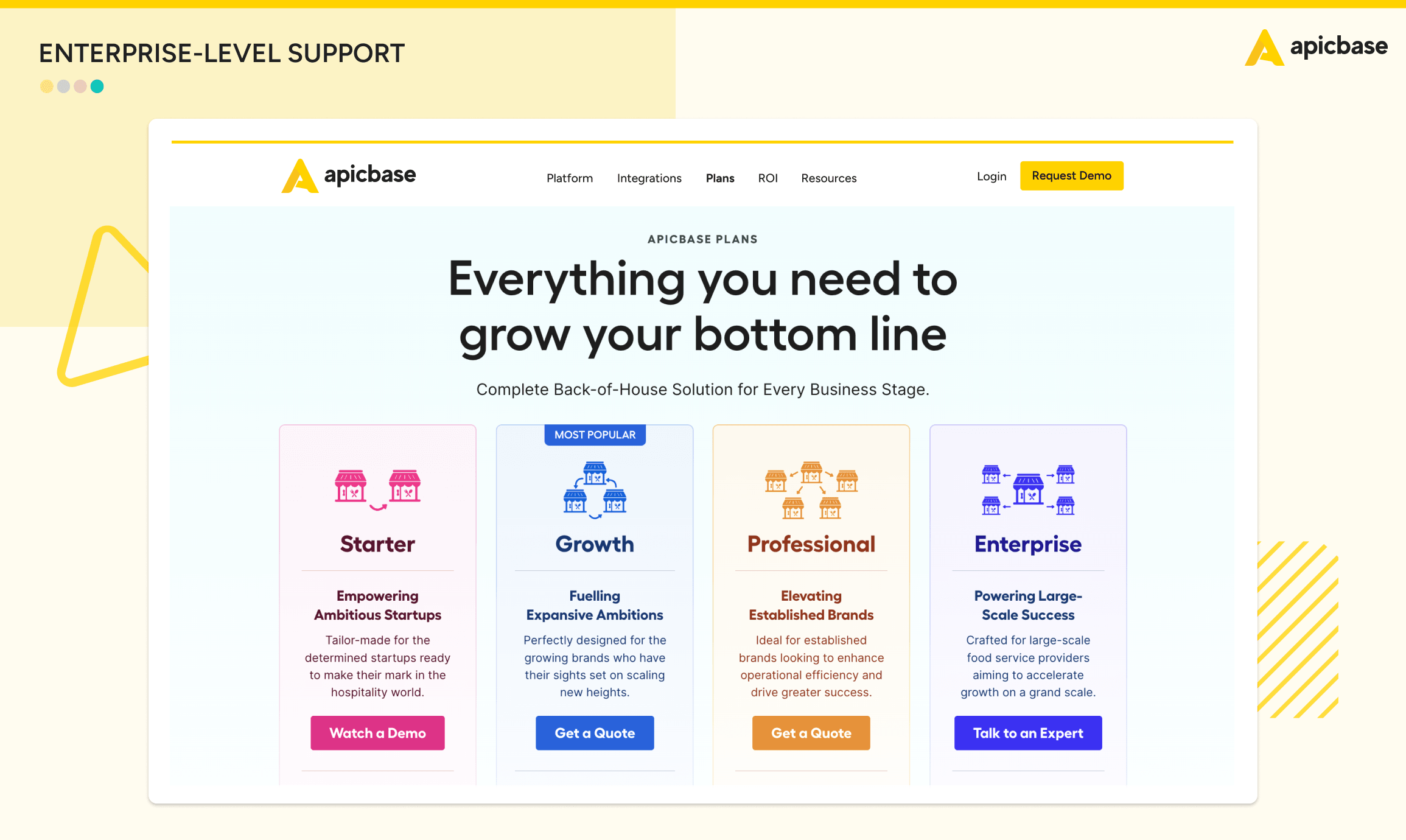
User reviews suggest that MarketMan’s customer support services are underdeveloped. In contrast, Apicbase has prioritised exceptional customer support to help its users maximise ROI and employee adoption. 35% of Apicbase’s full-time employees are part of the customer success team, making it the second-largest department of the company*. Apicbase offers comprehensive onboarding packs, various channels for inquiries, and extensive online resources. Customers frequently praise the effectiveness of Apicbase’s support processes and Apicbase’s professionalism in general.
One Apicbase customer said: “The team is eager to learn and improve the product based on our feedback. This creates a super valuable relationship where we both grow.”
*Product Development is the largest department, accounting for 55% of FTEs.
Other MarketMan Competitors
In addition to Apicbase, MarketMan’s competitors include top POS providers and restaurant management systems, each with their specialities, advantages, and weaknesses.
Let’s look at MarketMan’s other competitors in more detail.
Restaurant365
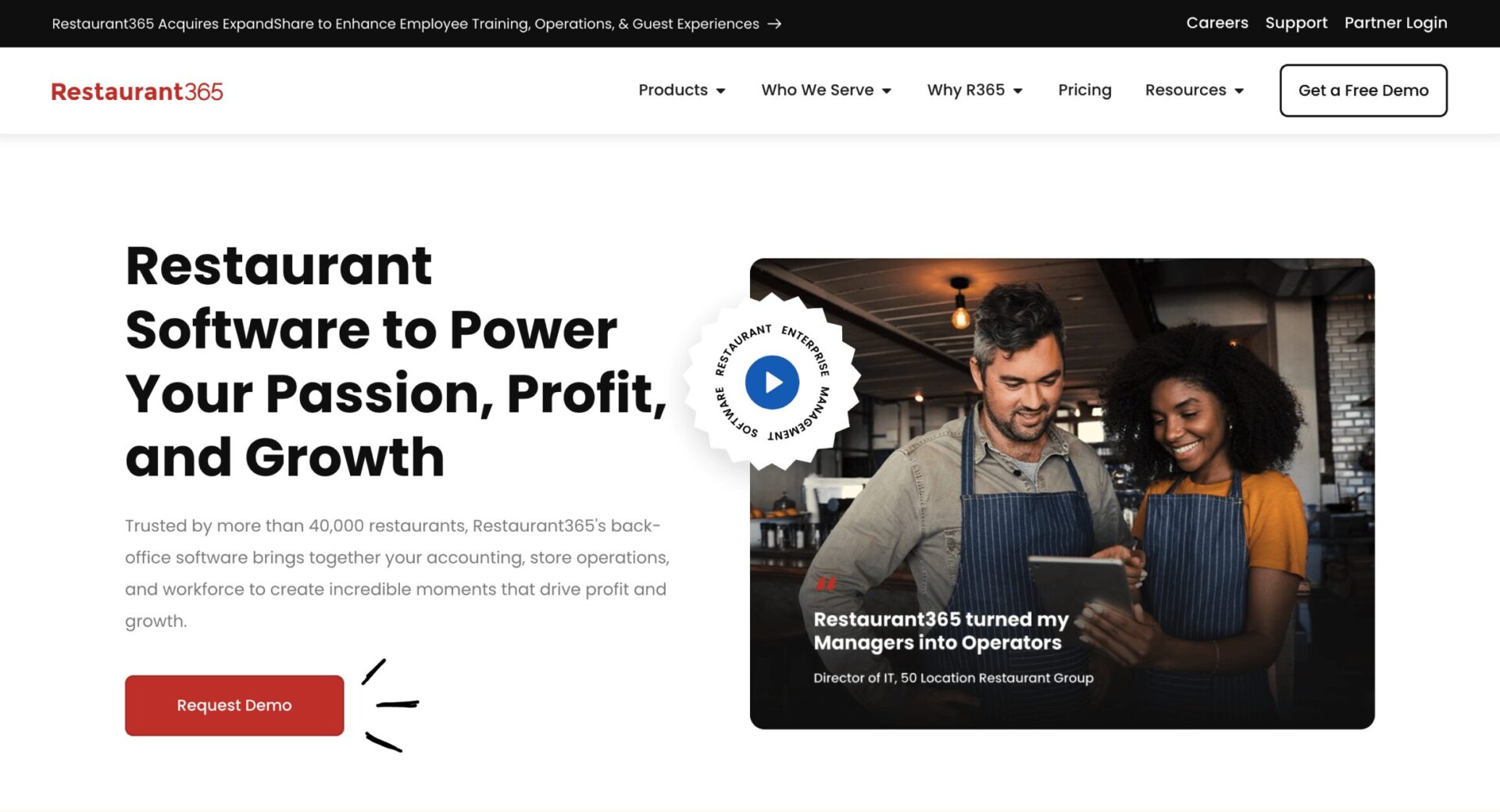
Restaurant365 is a back-of-house restaurant management software provider focusing on accounting, inventory and scheduling, workforce management, and analytics. It is a popular choice for BOH management, mainly for companies in the US. Although it overlaps with MarketMan on accounting, inventory management, and analytics, it doesn’t have the level of recipe management and food costing features a platform like Apicbase has.
Restroworks
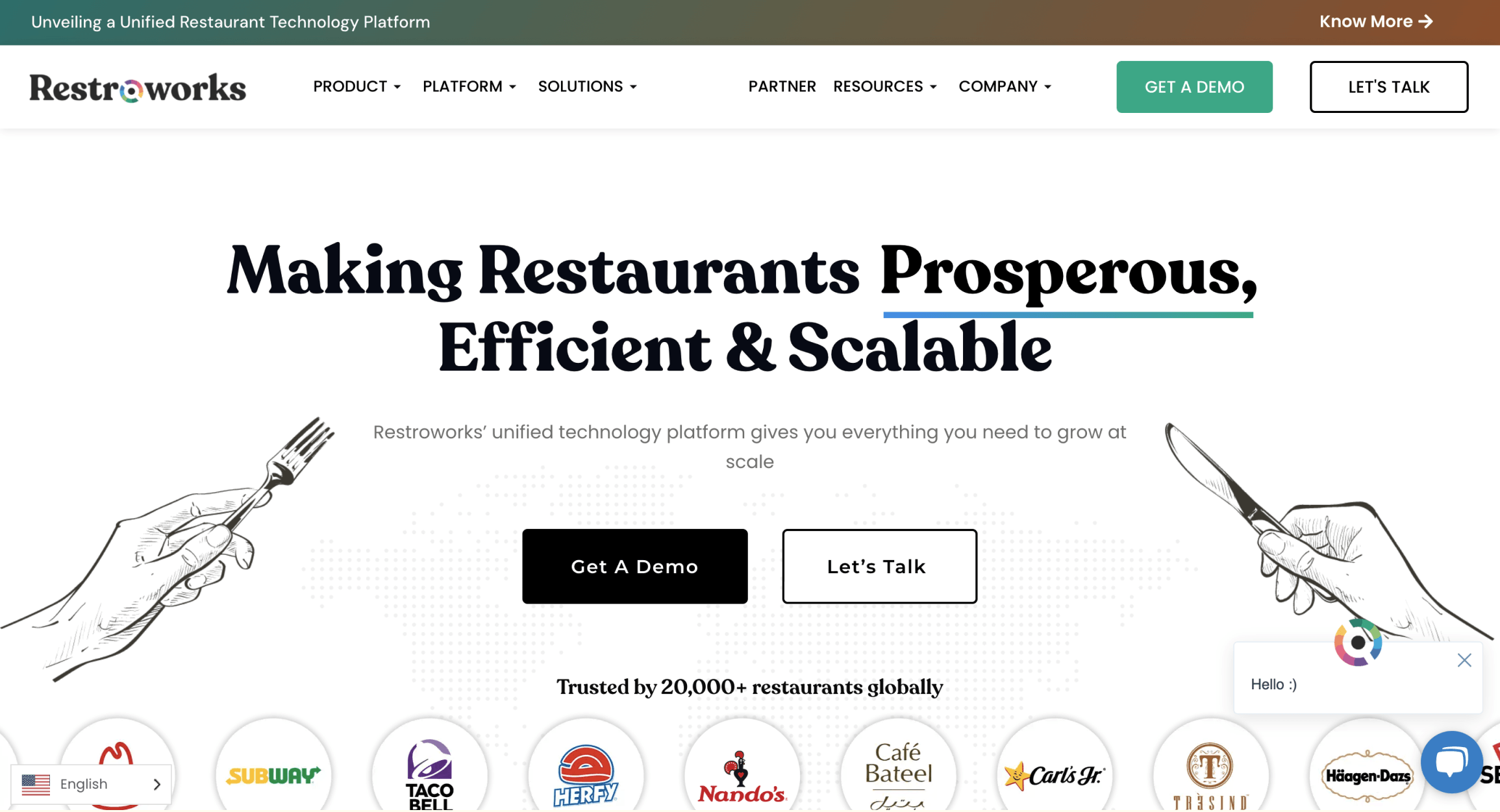
Restroworks is a restaurant management system that focuses on front and back-of-house operations. At its core, it is a POS system that has broadened its offering to include inventory, recipe, and supply chain management tools. It also offers a range of kitchen operations tools, such as a kitchen display system and production management features. Apicbase integrates with Restroworks.
Delaget
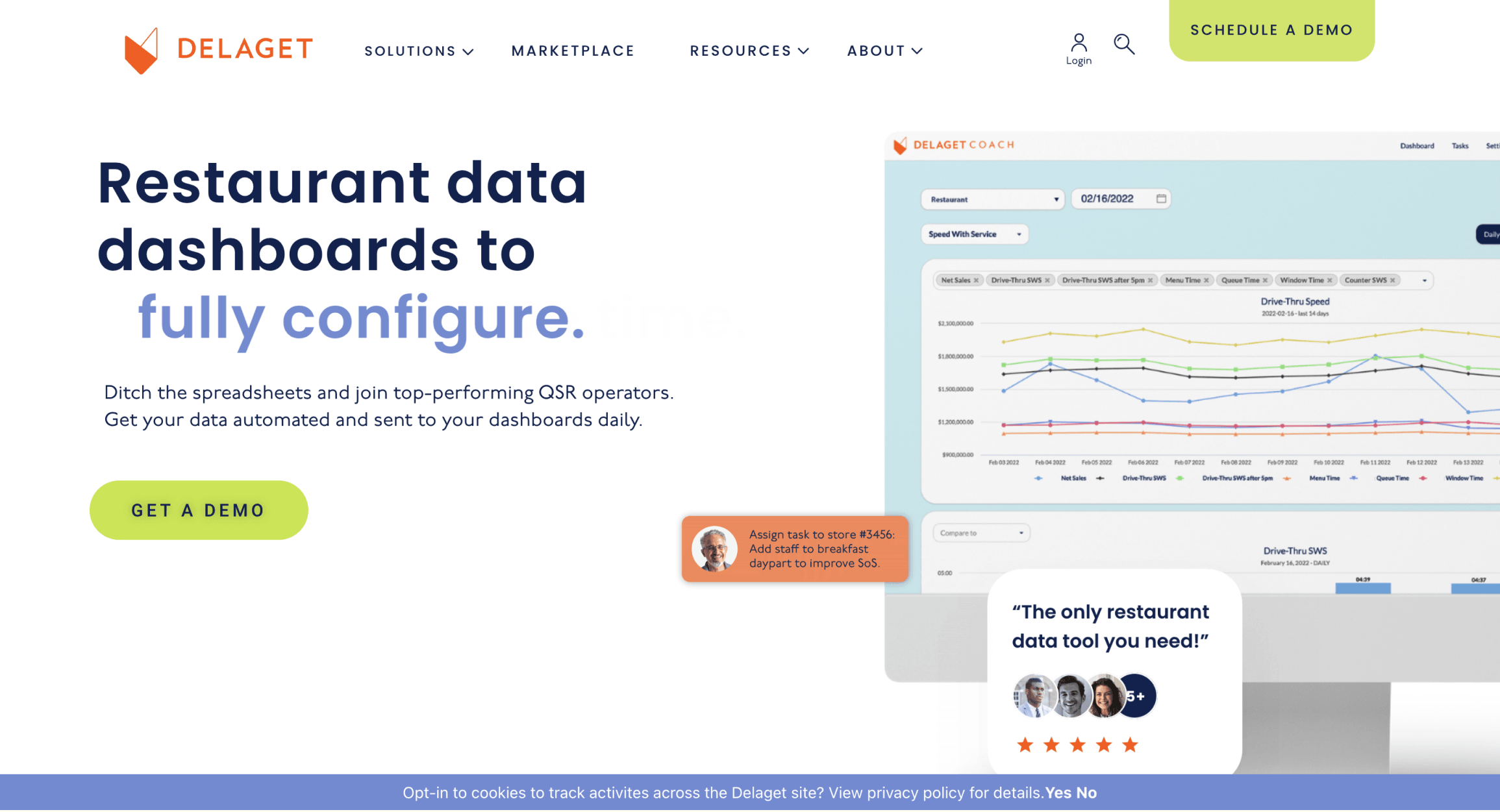
Delaget specialises in data analytics for QSR chains and other restaurants. The software provider competes with MarketMan in terms of helping restaurants uncover inefficiencies using their data and improve operational efficiency.
Oracle (Micros Symphony)
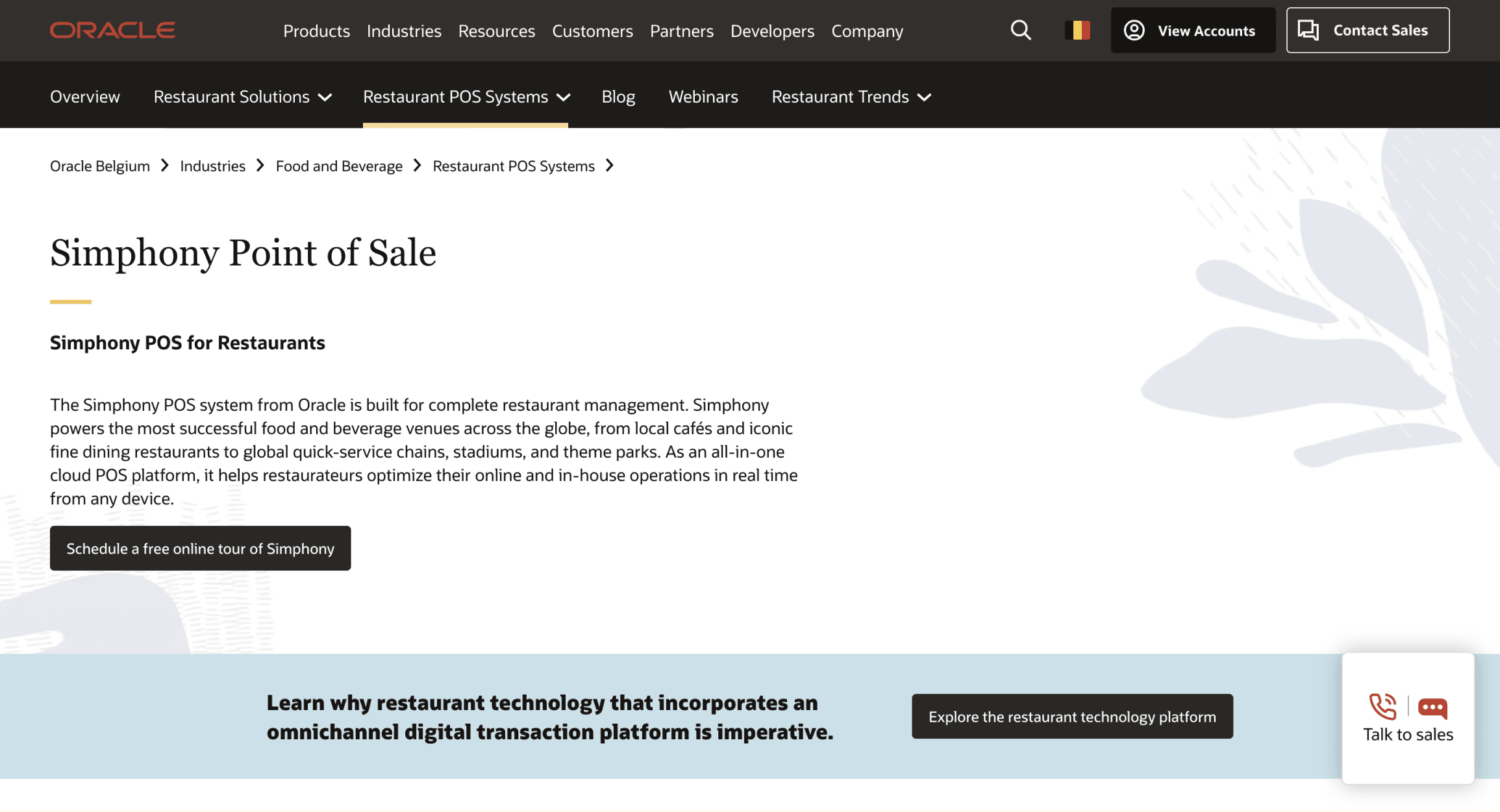
Micros Symphony from Oracle is a POS system that integrates numerous restaurant management features, from advanced ordering and delivery to inventory management. Oracle is a payments provider, so its focus is more on front-of-house, ordering and payments. As a more general restaurant management system, its inventory management features are less of a competitor to MarketMan than a dedicated system like Apicbase. Both MarketMan and Apicbase integrate with Micros.
Experience data-driven restaurant management
Most restaurant inventory management software appears similar at first glance, offering functionalities like storing recipes, managing stock, and ordering from suppliers.
However, the differences lie in how the systems manage the supply chain, raw materials, production processes, outlets, and central kitchens. These differences dictate which software best suits a particular type of restaurant or food service company.

Choose the Right Solution
If you need precise inventory monitoring across multiple locations to reduce discrepancies in food costs, consider Apicbase a solid alternative to MarketMan.
Get in touch to see if Apicbase fits your needs.

